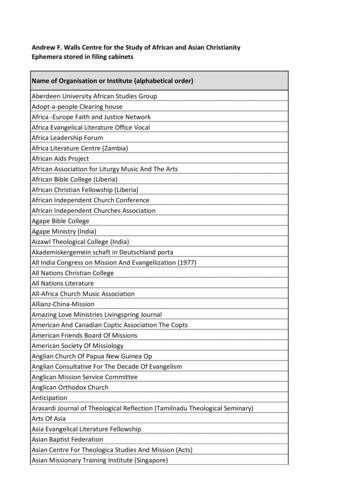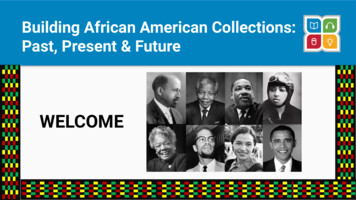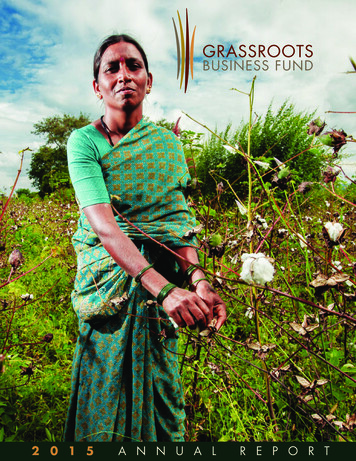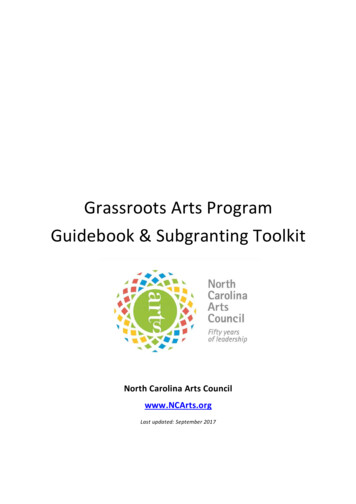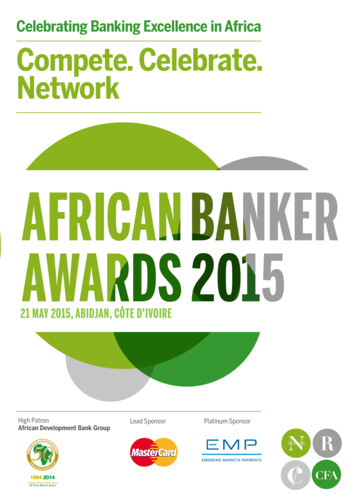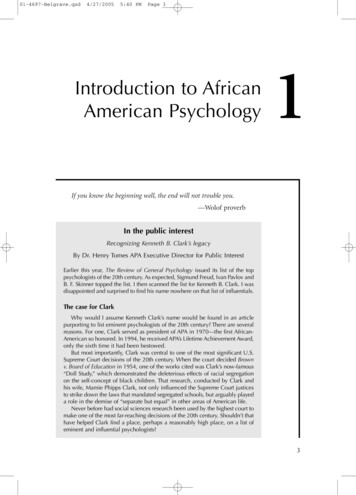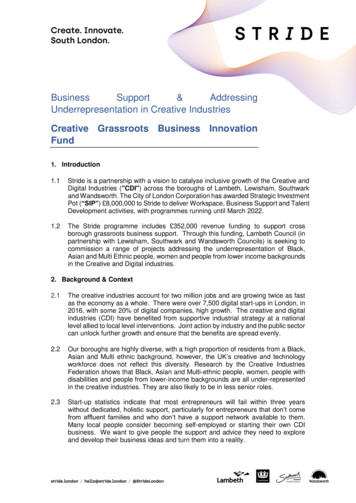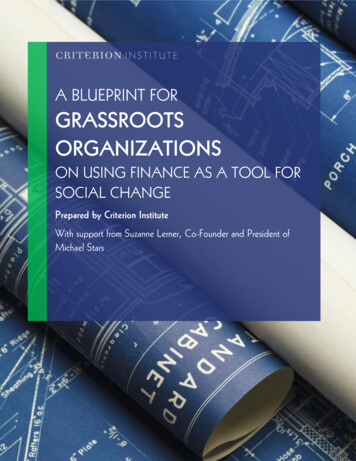
Transcription
Grassroots Development: The AfricanDevelopment FoundationJune 1988NTIS order #PB88-236252
Recommended Citation:U.S. Congress, Office of Technology Assessment, Grassroots Development: The African Development Foundation, OTA-F-378 (Washington, DC: U.S. Government Printing Office, June 1988).Library of Congress Catalog Card Number 8 8 - 6 0 0 5 2 6For sale by the Superintendent of DocumentsU.S. Government Printing Office, Washington, DC 20402-9325(order form can be found in the back of this report)
ForewordGrassroots development, to some, is a contradiction in terms. They identify development with industrialization, with large-scale transportation systems and U.S.-styleagriculture with its expensive equipment. To others, grassroots development is a meansto achieve results, an approach that has been missing from too many foreign aid programs and partly to blame for their failures, For yet others, grassroots development isan end in itself because it promotes people’s well-being and empowers self-help groupsto expand and make their own choices and bring about change.Grassroots development may be a little of all these things to the members of Congress who established the African Development Foundation (ADF) in 1980. This reportis about the Foundation - the only program wholly funded by the U.S. Congress to support grassroots development in Africa. Our analysis of ADF’s experience is broadly drawn;it will be of interest to anyone involved in self-help efforts of any kind. What works?What doesn’t? And why?This is OTA’S third report on U.S. foreign aid and African agriculture and the mostcomprehensive look at a single program. It complements a larger, more general workin press on enhancing agriculture in Africa and its already-published companion reporton the Sahel Development Program. The House Foreign Affairs Committee, its Subcommittee on Africa, and the House Select Committee on Hunger requested this study. TheSenate Foreign Relations Committee, Subcommittee on African Affairs, endorsed theirrequest.OTA’S special thanks go to the Washington-based and African staff of the Foundation who openly discussed their philosophy, their work, and their plans at length andwho spent their holidays reviewing our draft. Also, we gratefully acknowledge the helpof the people who participate in the 12 ADF-funded projects that we visited in Africa.They contributed their time, resources, knowledge, and enthusiasm to this assessmentand it could not have been done without their help. Many others shared their insightswith us, both in Africa and here in Washington. Members and leaders of the field teams,workshop participants, reviewers, and members of OTA’S Low-Resource AgricultureAdvisory Panel all deserve, and have, our appreciation. As with all OTA studies, thecontent of this report is solely OTA’S responsiblity.Ill
OTA Project Staff -grassroots Development:The African Development FoundationRoger C. Herdman, Assistant Director, OTAHealth and Life Sciences DivisionWalter E. Parham, Food and Renewable Resources, Program ManagerPhyllis N. Windle, Project DirectorAnalytical StaffKathy Desmond, ContractorGeorge Scharffenberger, ContractorScott McCormick, ContractorAllen Ruby, Research AnalystJ. Kathy Parker, ContractorValerie Brown, Research AssistantAdministrative StaffEllis Lewis, Administrative AssistantNellie Hammond, SecretaryCarolyn Swarm, Secretary
ContentsPageAbbreviations and Acronyms . . . . . . . . . . . . . . . . . . . . . . . . . . . . . . . . . . . . . . . . . . viChapterl. Summary and Options . . . . . . . . . . . . . . . . . . . . . . . . . . . . . . . . . . . . . . . . 3Chapter2. OTA’s Assessment Methods . . . . . . . . . . . . . . . . . . . . . . . . . . . . . . . . . . . 23Chapter 3. The African Development Foundation. . . . . . . . . . . . . . . . . . . . . . . . . . . 35Chapter4. OTA’S Findings About ADF-Funded Projects . . . . . . . . . . . . . . . . . . . . . 53Chapter 5. OTA’S Findings About ADF’s Funding Program . . . . . . . . . . . . . . . . . . 85Chapter6. Lessons for Other Development Assistance Organizations . . . . .115Appendix A. ADF Projects Awarded From Fiscal Year 1984 ThroughFiscal Year 1987 . . . . . . . . . . . . . . . . . . . . . . . . . . . . . . . . . . . . . .123Appendix B.Summaries of 12 ADF-Funded Projects Visited by OTA . .126Appendix C,Desk Reviewers, Participants in the Methods Workshop,and Members of OTA Field Assessment Teams . . . . . . . . , . . . , . . .146Appendix D. Field Team Methods: The Assessment Materials . .148Appendix E.Field Interviews , ., . . . . . . . . . . . . . . . . . . . . ., . . . . . . . . . . .,165Appendix F.Reviewers of OTA’s Draft . . . . . . . . . . . . .,.,.,.172Appendix G, References . . . . . . . . . . . . . . . . . . . . . . . . . . . . . . . . . . . . . . . . . . . .174Index . . . . . . . . . . . . . . . . . . . . . . . . . . . . . . . . . . . . . . . . . . . . . . . . . . . . . . . . . . . . . .179
ABBREVIATIONS AND ACRONYMS—African Development Foundation—Agricultural Finance Corporation(Zimbabwe)AID—U.S. Agency for International DevelopmentAJAC—Association of Young Farmers of theCasamance (Senegal; acronym forFrench name)ALDEP—Arable Lands Development Program(Botswana)—Boiteko Agricultural ManagementAMAAssociation (Botswana)app.—appendix—Arable Rainfed Agricultural ProgramARAP(Botswana)—Appropriate Technology InternationalATICEBEMO —Dutch Catholic development assistance program (acronym for Dutchname)CONGAD —Council of Nongovernmental Organizations Supporting Development(Senegal; acronym for French name)–Country Resource Facilitator (ADF)CRF—Canadian University Service OrgaCusonization–Dakoro Herders Cooperative (Niger)DHC—Food and Agriculture OrganizationFAOof the United Nations—Federation of Nongovernmental OrFONGSganizations of Senegal (acronym forFrench name)–Foundation Representative (ADF)FR—Farming Systems KenyaFSKFTE—Full-time equivalentFY—Fiscal year—General Accounting OfficeGAOADFAFCvi—Inter-American Foundation—International Business Machines, Inc.—International Centre of Insect Physiology and Ecology—International Fund for AgriculturalIFADDevelopmentIUCN—International Union for the Conservation of Nature and Natural ResourcesKFM—Kungal Fado Mango (Niger; acronymfor Fulani name)MISEREOR—German Catholic bishops development assistance programNGK–Njoguini, Gitero and Kabati Self-Helpproject (Kenya)—Non-governmental organizationNGONOVIB—Dutch private development assistanceorganization (acronym for Dutchname)OMB–Office of Management and Budget—Office of Technology AssessmentOTA—Privrte Agencies Collaborating ToPACTgether—Project Assessment MemorandumPAM(ADF)Pm—Partnership for Productivity/KenyaPRC–Project Review Committee (ADF)—Private voluntary organizationPvoRLO–Regional Liaison Officer (ADF)SAED—Government regional developmentagency for the Senegal River Valley(acronym for French name)—United NationsUNUNIFEM —United Nations Development Fundfor Women—Women in developmentWIDIAFIBMICIPE
Chapter 1Summnary and Options
CONTENTSSummary . . . . . . . . . . . . . . . . . . .3357100 . . . . . . . . . . . . . . . . . . . . . . . . . . . . . . . . . . . . .Scope and Methods. . . . . . . . . . . . . . . . . . . . . . . . . . . . . . . . . . . . . . . . . . . . . . .ADF Yesterday and Today . . . . . . . . . . . . . . . . . . . . . . . . . . . . . . . . . . . . . . . . .How Well Are ADF-Funded Projects Doing? . . . . . . . . . . . . . . . . . . . . . . . . .ADF’s Program and Possible Improvements . . . . . . . . . . . . . . . . . . . . . . . . . .Lessons for other Organizations . . . . . . . . . . . . . . . . . . . . . . . . . . . . . . . . . . . .Congressional Options . . . . . . . . . . . . . . . . . . . . . . . . . . . . . . . . . . . . .Reauthorization: Permanent v. 5-Year . . . . . . . . . . . . . . . . . . . . . . . . . . . . . . .Appropriations. . . . . . . .Congressional OversightLegislation. . . . . . . . . . . .121213141517BoxPageBox1-1. ADF’s Legislation in Brief A Mandate for Grassroots Development . . . 17FiguresFigure1-l. Countries With ADF-Funded Projects . . . . . . . . . . . . . . . . . . . . . . . . . . . . . . 4l-2. Flow Chart of OTA’s Assessment Methods, . . . . . . . . . . . . . . . . . . . . . . . . 5TablesTablePagel-1. The 12 ADF Projects Visited by OTA Teams . . . . . . . . . . . . . . . . . . . . . . . 6l-2. Rating the Critical Issues in 12 ADF-Funded Projects . . . . . . . . . . . . . . . , 71-3. Summary of Congressional options . . . . . . . . . . . . . . . . . . . . . . . . . . . . 1 3.
Chapter 1Summary and OptionsSUMMARYThe African Development Foundation (ADF)is a small U.S. development assistance agencyfaced with a large task: supporting grassrootsdevelopment in Africa. Congress created ADFin 1980 to “enable the poor to participate inthe process of development. ” As of 1987, ADFhas given grants to organizations in 19 African countries and its FY 88 appropriations were 7,0 million (figure l-l).OTA’S assessment confirmed the validity ofthe assumptions on which ADF was createdand found that most ADF-funded projects weredoing reasonably well. While a number of areasfor improvement were identified, OTA concluded that the Foundation’s reauthorizationis justified, ADF would need additional funding, however, if it is to implement recommendedimprovements without reducing the funds available for new grants.Scope and MethodsThis report, done at the request of the HouseForeign Affairs Committee, its Subcommitteeon Africa, and the House Select Committee onHunger, is intended to assist Congress with decisions about the African Development Foundation’s role in U.S. foreign assistance. Consequently, this is not an evaluation of specificADF-funded projects. Most of the Foundation’sprojects are in early stages of implementationand any final analysis must await their completion. Nor is this the final word on ADF. TheFoundation is young and evolving. It has hadsome successes, and some problems. This report suggests some ways to overcome theseproblems and thus enable the Foundation tofulfill more effectively the unique role that Congress has designated for it.This report examines ADF’s overall fundingprogram with a special focus on its agricultureand renewable resources projects and the useof technology. As Congress requested, it looksat the broad impacts of ADF’s work: the results,replicability, and sustainability of its projects;and how it fosters the participation of Africansin their own social and economic development(figure 1-2).The assessment began with an analysis of recent evaluations of similar organizations tocompare different evaluation methods andidentify common problems. In addition, expertsin project and program evaluation, grassrootsdevelopment, and field evaluation methodswere interviewed. Project files in ADF’s Washington office were carefully reviewed to provide an overview of the Foundation’s fundingprogram and highlight potential problem areas.Field visits to 12 representative ADF-fundedprojects (table 1-1) and interviews with Africanand donor officials in Africa formed the foundation of the report’s findings, Three regionalfield teams visited 6 countries, spending a total of 285 person-days gathering and analyzinginformation and suggesting possible improvements that ADF could undertake.The Foundation cooperated fully with allparts of this work. For example, discussionswith ADF staff provided a broad picture ofADF’s activities. Members of the Foundation’sAfrican staff accompanied the OTA field teamson their site visits and assisted with local arrangements, Also, ADF provided substantial review comments while this report was in draftform. At the same time, however, OTA soughtto ensure that its results were independent:selection criteria stipulated that no field teammembers had previous or current contractualrelationships with the Foundation; ADF fieldstaff did not participate in most interviews, including meetings with project managers; andthe Foundation did not have access to OTA’Sfield assessment materials or the three teams’reports.3
4Figurel.1 .—Countries With ADF.Funded ProjectsSUDAN\\/.[LRMap adapted from the African-American Institute, Inc., copyright @ 1984./
5Figure 1 -2.— Flow Chart of OTA’S AssessmentMethodsOTA experienceCONGRESSIONAL REQUEST\I/Identification of critical issues1. Participation3. Sustainability2. Results4. ReplicabilityTechnology (in relation to the other four issues)Assessment MethodsWorksHop\IMeetingWASHINGTON DESK REVIEWS ON1. AGRICULTURAL TECHNOLOGY2. RENEWABLE RESOURCETECHNOLOGY3. PARTICIPATIONFIELD ASSESSMENT WORKSHEETS AND FORMSrIIIIIIChoice of indicators toNational-level interviewsProject visitsField Team Wrap-Up MeetingsINDIVIDUAL ASSESSMENTS OFCONGRESSIONAL OPTIONSD RA FT REPORTFINAL REPORTKEY: Items printed m capital letters are repcxts or wtten materialsItems printed In bold are meetmgsSOURCE: Offtce of Technology Assessment, 19SSADF Yesterday and TodayThe Foundation was established by Congressin 1980 to complement official bilateral andmultilateral development assistance programssuch as those of the Agency for InternationalDevelopment (AID) and the United Nations.ADF’s legislation was modeled on the InterAmerican Foundation but its history is quitedifferent. ADF had a difficult start. First, theAdministration delayed appointment of ADF’sBoard of Directors until 1983. This stalled theagency’s start-up because ADF’s legislation required that the U.S. President appoint a Boardto be responsible for the Foundation’s management and to select its president. Then, highlevel staff resigned in 1984 creating more uncertainty about ADF’s program. As a result,Congress asked the General Accounting Office(GAO) to assess ADF’s management capacityto implement its mandate. Although GAO raisedsome difficult issues, its qualified endorsementof ADF’s capabilities led Congress to reauthorize ADF for five years beginning in 1985.In 1984, under the leadership of a new president, the Foundation began to develop its funding program in earnest. Procedures were devised to identify potential grantees, approvegrants, and conduct project monitoring andevaluation. Some processes, such as project approval, have changed little since 1984. Others,such as research and evaluation procedures,are being developed further now as the firstprojects are reaching completion, Certain keyactivities, such as the responsibilities for projectapproval, are under continuing ADF review,ADF’s Washington and Africa-based staffgrew to 52 full- and part-time employees, contractors, and interns by February 1988. Twentyfive staff members are full-time employees,within the Office of Management and Budget’s27 full-time employee limit. Virtually all funding decisions are made in Washington, e.g.,screening, reviewing, and approving projectproposals. The addition of ADF’s African staff(4 regional officers and 14 part-time countryresource facilitators) is recent, however, andmay alter this high degree of centralization.ADF has awarded grants to 114 projects in19 countries in Africa totaling 10.3 million in
6-(40U2commUTUJcocom.m:Cu. cor-o00o0hmU-J0“m“-“:OJ0--l
7the past 4 fiscal years (1984-1987). Individualgrants range from 700 to 250,000; projectsaverage approximately 90,000, including grantamendments. Most commitments are for 2 to3 years. Two-thirds of the projects have agricultural activities as a major component; somesupport other rural activities such as potablewater supply and still others provide aid to urban organizations (20 percent). The Foundationawards grants to grassroots organizations andto intermediary organizations that provide services to local groups, Funded groups use ADFmoney to repair wells, build small-scale irrigation systems, improve animal health, plantvegetable gardens and orchards, rent tractors,raise chickens, obtain credit for fertilizer, formcooperatives, and many other activities. ADFgrants enable intermediary organizations toprovide services such as credit, training andtechnical assistance to grassroots groups.How Well Are ADF-FundedProjects Doing?People’s participation in ADF-funded projects, the projects’ sustainability over time, andtheir replicability from location to location arefundamental aspects of ADF’s congressionalmandate. And appreciable positive results, leading to social and economic development, areexpected to be a major outcome of supportinggrassroots efforts. Therefore, these were thefour critical issues—participation, positive results, sustainability, and replicability—onwhich the performance of the 12 visited projectswas assessed (table 1-2).Table 1-2.—Rating the Critical Issuesin 12 ADF-Funded ProjectsNo. of projects ratedCritical issueHighOverall Degree of Participation . . . 6Overall Results . . . . . . . . . . . . . . . . . 4OveraIl Sustainability (for next 3to 5 years) . . . . . . . . . . . . . . . . . . . 6Overall Replicability in Regionor Country . . . . . . . . . . . . . . . . . . . 3Moderate Low2“6425172ParticipationFostering the participation of Africans intheir own development is an important goal ofADF. This assessment of 12 ADF-funded projects showed high overall participation in onehalf of the projects but low overall participation in one-third. These ratings were adjustedfor the local context and were based on elements such as people’s support for project design and its technologies; their access to theproject and benefits in light of their contributions; their role in project decisionmaking; andhow participatory the recipient organizationsare.A number of issues remain for ADF to settleand, if addressed, are likely to improve theFoundation’s record on participation, For example, ADF must give increased attention tothe various elements that characterize participation, rather than allowing one, local control,to supersede all others. A project may be controlled locally, yet people who contribute timeor other resources may not support the activities undertaken or take part in decisionmaking. Involvement in decisionmaking seems tobe key but ADF has little information on thisor other elements of participation.In the 12 cases studied, either an Africangrassroots group or intermediary organizationoriginated the project in every case. Of thefunded groups visited, four were grassrootsorganizations and eight were intermediaryorganizations. More intermediary organizations had low participation than grassrootsgroups. Both types of organizations face difficult questions of access. For example, womenhave a low degree of access to projects in onethird of the projects visited, and rarely participated in management.Generally, participants were representativeof the community, agreed the project addresseda need, and shared equitably in costs and benefits. On the other hand, usually participantsdid not take part in evaluation and financialdecisionmaking. A third of the projects werejudged low on participants’ acceptance of theproposed technologies, their share in project
8management, and participatory provision oftechnical assistance. Results One of ADF’s main purposes is to help bringabout social and economic development. A wayto assess whether ADF is achieving this purpose is to evaluate the results of ADF-fundedprojects. OTA’S rating of results was based onwhether projects achieved their objectives and,more importantly, whether positive economicand social impacts had occurred, or were likelyto occur, without significant negative effects,including those on the environment.Because of the early stage of most of the projects visited, project results could only be estimated. Actual impacts were observable in onlyhalf of the projects. Ten projects were judgedlikely to have positive impacts on social andeconomic development of poor people in thelocale but the levels of impact varied from significant to negligible. One project brought abouta 30 percent increase in income for women whoreceived small agricultural loans; an irrigationproject doubled land value in another. Twoother projects, however, were unlikely to benefit the poor even though they were likely toreach some of their objectives.To adequately assess the results, or outcomes,of projects, the benefits must be considered inrelation to the costs. Thus, OTA considered thecontributions of ADF, the local communities,and other donors.Ž Grant size and numbers of participants varied widely. As a result, ADF’s grant sizeper person ranged from 50 to 3,507, averaging 650. Just under one-half of the money ADF isputting into the 12 visited projects is spentfor equipment. Another 18 percent goesinto revolving credit funds. About 10 percent is spent in each of three categories:1) agricultural inputs, 2) salaries and officeexpenses, and 3) ADF audits, evaluations,and other expenses including contingencyfunds. The remainder funds vehicles, transportation, training, and technical assistance.Communities usually provide labor forprojects. In six projects, a majority of participants also provide some money and materials.All 12 of the visited organizations were recipients of funds from other externaldonors in addition to ADF. In four of thesecases, the specific project funded by ADFwas also funded by other donors. The otherdonors include AID, the U.S. Ambassador’s Self-Help Fund, European religiousdonors, European and U.S. private voluntary organizations (PVOS), private foundations, the World Bank, and the African Development Bank.SustainabilitySustainability generally means that projectactivities or results will continue after the grantperiod. OTA judged ADF-funded projects onseveral levels: sustainability of the project, ofproject-related activities, and of the local groupand/or intermediary organization. Also, sustainability includes economic, environmental,technical, and social factors; each was assessedindependently but then combined in an overall rating.Almost all ADF-funded activities were judgedto have a high or moderate potential to be sustainable over the next 3 to 5 years. Changeswere underway in a number of projects, though,and their eventual form might differ considerably from that proposed in the original projectdocumentation. Community support and theself-help nature of the projects were the strongest reasons for sustainability. But the lack ofcareful economic and environmental planningwere common constraints threatening sustainability, especially in the longer term. The mostcommon constraint to economic sustainability in ADF-funded projects is lack of provisionfor future ongoing, or recurrent, costs (affecting five projects). Three projects already shownegative environmental consequences—soilerosion, soil compaction, and land clearingwithout adequate reforestation.The poorer performance of ADF-funded projects regarding longer term sustainability also
9relates to the technologies being used. Almostall of the projects were judged technologicallysustainable in the short term. Technologiesused in nine projects, however, were relativelyhigh risk; those in five were relatively complex;and those in five were comparatively high cost.RepIicabilityDonors seek replicability to increase the impact of their funding program, Grantmakers,such as ADF, that fund small-scale projects intend that their sponsored projects will benefitlocal people, but they also intend them to havewider impacts. Replicability refers to more thanthe duplication of project activities, it includesdissemination of technologies, organizationalmethods, or skills beyond the funded group. Injudging replicability of projects, OTA considered 1) the potential for other groups in the region or country to use the technology or repeatthe project activity and 2) whether aspects ofthe organization’s management structure orstyle could be beneficial to other groups.Ten of the ADF-funded projects visited showeda moderate or high degree of replicability inthe region or country, and two a low degree.Self-help processes, such as the ways groupsidentified, planned, or managed their activities,were judged more likely to be replicable thanthe technologies used. The major constraint toreplicability was the high cost of the projectactivities or technology. In seven projects, morethan one-half of those visited, project activitieswere judged unlikely to be repeated for this reason. However, the majority of funded groupsmade some effort to spread what they learned.Most intermediary organizations planned toreplicate project activities with additional local groups. In three cases, non-participantsadopted technologies introduced by the ADFfunded projects.Interestingly, three projects involving grassroots organizations have had an impact on national institutions. One was among the first village associations to obtain credit from the newNational Agricultural Credit Bank in Senegal.Its successful irrigated rice project raised theexpectation that other local associations couldPhotocredit:OTA/GeorgeHonadleADF funding allows groups to tap the wisdom andexperience of their local leaders. This man leads afarmers’ cooperative that produces tea and coffeein eastern Zimbabwe.also handle credit. Another is seen by the Botswana Ministry of Agriculture as a successfulpilot project on vegetable and poultry/egg production, worthy to be tried elsewhere by theMinistry. The third, a water supply and irrigation system built by residents of three communities, provides Kenyan officials with an example of lower cost local water projects.How the Four Critical Issues InteractParticipation, positive results, short- and longterm sustainability, and replicability are alldesirable but not necessarily simultaneouslycompatible. Generally, participation increasesresults. And positive results can increase participation and be a condition for replicability.On the other hand, over-emphasizing resultscan lessen participation, especially in the shortterm. And neither participation nor results arenecessarily compatible with long-term sustainability, especially with environmental sustainability if dangers are dimly perceived. Thus ADFneeds to balance the demands of these different aspects of its mandate in implementing itsfunding program.
10ADF's Program and PossibleimprovementsMany of the ADF-funded projects that OTAexamined are performing reasonably well. Some,however, have deficiencies regarding participation, sustainability, and replicability that aretroubling given ADF’s mandate. The Foundation inevitably made difficult choices as it translated its mandate into action. Together, thoseexplicit and implicit choices have shaped ADF’sfunding program and they are reflected in theproject findings discussed here.The Foundation’s choices in several areashave had clearly positive impacts. The Foundation has a highly committed staff with considerable African experience and it has contracted with qualified Africans to help carryout its program. It supports the growth of grassroots leadership and organizational capacityand its grant-making process is often flexibleand responsive. The focus on agricultural projects is appropriate, and ADF’s new evaluationprogram is promising.In other areas, however, ADF is doing lessthan it could. Five major areas of improvementexist:1. ADF’s relationships with its applicants andgrantees are not as effective as they could be.Decisions regarding ADF’s evolving role vis avis each funded group, such as the level of involvement, frequency of contact, and the balance between facilitation and evaluation, couldbe improved. Often ADF is too passive but attimes it is too involved. In the former case, potential to assist the group’s development is neglected. In the latter, the self-help process maybe bypassed inappropriately.2. Pre-funding analysis of project proposalsis often inadequate in one or more of severalcritical areas: the sociallpolitical context andorganizational factors of the applicant group,technological choices, environmental implications, and the economic constraints and opportunities of the projected activities. Although ADF encourages a high degreeof local control, other critical elements ofparticipation, such as participants’ involve- ment in decisionmaking and access bywomen, minority groups, and the poor, arenot sufficiently addressed. Thus, ADF isnot fully meeting its mandate to foster participation by the poor in their own development.ADF’s analysis of the stage of development—the growth and track record—of applicant groups and their relationship togovernment officials and other donors oftenis weak. Similarly, analysis of intermediary organizations and their relationshipswith grassroots groups has not been sufficient. As a result, ADF sometimes makesinappropriate decisions as to who, when,what or at what level to grant funding.Inadequate analysis of technical, environmental, and economic factors sometimesresults in ADF funding projects with questionable technical soundness, economicand financial viability, and environmentalsustainability. Also, ADF’s work has nothelped expand the choices of technologiesavailable.3. The way that ADF monitors projects oftendoes not provide enough in-depth understanding and information to effectively facilitate implementation by project managers and participants. As a result, the Foundation missesopportunities to assist grantees and increasethe likelihood of project success.4. ADF African field staff are underused inpre-funding analysis and project monitoring.This slows decisionmaking, causes ADF tomake funding decisions without the helpfulanalysis they could provide, and also means thatfunded groups are not receiving the best possible assistance.5. ADF does not communicate sufficientlywith other private and official developmentgroups in Africa, so its ability to learn fromothers’ experience and to help groups benefitfrom others’ resources is reduced. Also, ADFdoes not prepare country-specific planningstrategies to guide its use of sparse resourcesand place its work in context. Th
is a small U.S. development assistance agency faced with a large task: supporting grassroots development in Africa. Congress created ADF in 1980 to "enable the poor to participate in the process of development. " As of 1987, ADF has given grants to organizations in 19 Afri-can countries and its FY 88 appropriations were 7,0 million (figure .


